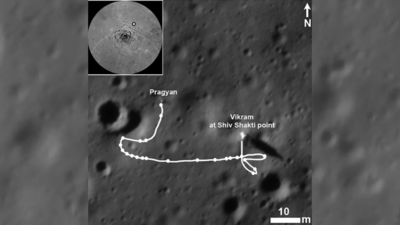
India, China find ancient moon mantle materials key to early formation
BENGALURU: In what can be pegged as a crucial finding that would benefit global endeavours returning to the Moon, India’s Chandrayaan-3 and China’s
Chang'e-6
missions have independently discovered primitive
lunar mantle materials
near the Moon's South Pole-Aitken (SPA) basin.
The discoveries in two separate studies published in the journal Nature — China’s paper was published on April 23, India’s on April 25 — point to a growing scientific interest in probing
planetary interiors
via polar exploration, adding critical pieces to the puzzle of how the Moon, and rocky planets like Earth, formed and evolved.
India’s findings come from in-situ surface analysis and China’s from returned samples. Despite different methodologies, both discoveries provide insight into the Moon's early formation and evolution, highlighting the South Pole region as a treasure trove of lunar history. They point to the SPA basin as a unique site where the Moon’s deep history lies exposed.
The Indian study by a team of scientists from Isro’s
Physical Research Laboratory
(PRL) shows how Pragyan, the rover on Chandrayaan-3, detected soil with low sodium and potassium but high sulphur content, suggesting materials from the Moon's deep interior rather than its crust.
“The Alpha Particle X-ray Spectrometer (APXS) aboard Pragyan directly measured the elemental composition of the Moon’s surface at an unexplored location, Shiv Shakti station located at 69.37° S, 32.32° E in the southern high-latitude highlands of the nearside of the Moon,” Isro said.
Pragyan analysed surface soils in the southern highlands, about 350km from the SPA rim. “The study has revealed the potential presence of primitive lunar mantle materials at the [Chandrayaan-3] landing site, which was excavated during formation of the SPA,” PRL scientists said.
Elaborating further, Isro said that the rover detecting unusually low levels of sodium and potassium, and a distinct enrichment in sulphur points to a chemical profile that diverges from those recorded at previous lunar landing sites.
It suggests limited influence from “KREEP-rich materials” — products of late-stage magma crystallisation. Instead, the data point to a mix of lower crust and upper mantle materials excavated by the ancient SPA impact.
The Indian team concluded that the sulphur likely originated from deep within the Moon, possibly as iron sulphide (FeS), and not from external sources such as meteorites. This supports the view that the Chandrayaan-3 site preserves early, unaltered signatures from the Moon’s interior.
Meanwhile, China’s mission has returned samples containing rare magnesian olivine grains with high nickel concentrations, representing the most primitive mantle materials ever recovered.
As per the study based on samples returned from the Chang’e-6 mission, which landed within the SPA basin, some of the grains, with nickel concentrations up to 682 parts per million, are said to represent the most primitive mantle materials yet recovered.
Their composition matches model predictions for the earliest olivines crystallised from the lunar magma ocean. Researchers suggest these mantle fragments were brought to the surface by ascending high-magnesium lavas and preserved in the SPA basin’s impact-shattered crust.
As per the study, the olivines’ oxygen isotope ratios align with the terrestrial fractionation line, confirming their lunar origin. Their high magnesium and nickel levels distinguish them from previously known crustal rocks and suggest a direct link to early mantle differentiation.

 1 month ago
170
1 month ago
170




























 English (US)
English (US)